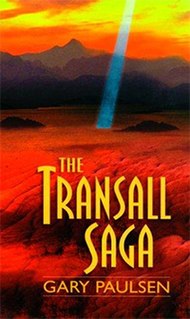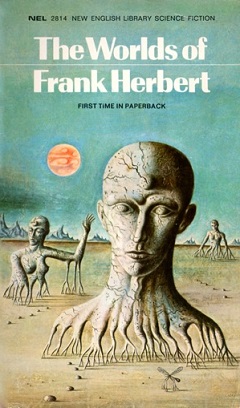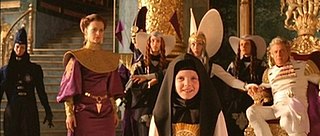Related Research Articles

Franklin Patrick Herbert Jr. was an American science-fiction author best known for the 1965 novel Dune and its five sequels. Though he became famous for his novels, he also wrote short stories and worked as a newspaper journalist, photographer, book reviewer, ecological consultant, and lecturer.

Dune is a 1965 science fiction novel by American author Frank Herbert, originally published as two separate serials in Analog magazine. It tied with Roger Zelazny's This Immortal for the Hugo Award in 1966, and it won the inaugural Nebula Award for Best Novel. It is the first installment of the Dune saga, and in 2003 was cited as the world's best-selling science fiction novel.

The alien invasion or space invasion is a common feature in science fiction stories and film, in which extraterrestrials invade the Earth either to exterminate and supplant human life, enslave it under an intense state, harvest people for food, steal the planet's resources, or destroy the planet altogether.

Dune is a science fiction media franchise that originated with the 1965 novel Dune by Frank Herbert and has continued to add new publications up to 2017. Dune is frequently cited as the best selling science fiction novel in history. It won the 1966 Hugo Award and the inaugural Nebula Award for Best Novel, and was later adapted into a 1984 film and a 2000 television miniseries. Herbert wrote five sequels, and the first two were presented as a miniseries in 2003. The Dune universe has also inspired some traditional games and a series of video games. Since 2009, the names of planets from the Dune novels have been adopted for the real-world nomenclature of plains and other features on Saturn's moon Titan.

Hellstrom's Hive is a 1973 science fiction novel by Frank Herbert. It is about a secret group of humans who model their lives upon social insects, and the unsettling events that unfold after they are discovered by a deep undercover agency of the US government.
"The Tactful Saboteur" is a science fiction novelette by American writer Frank Herbert, which first appeared in Galaxy Science Fiction magazine in October 1964. It established the setting for Herbert's ConSentiency universe, one of his three elaborate universes or franchises spanning multiple volumes.

The Hellstrom Chronicle is an American film released in 1971 which combines elements of documentary, science fiction, horror and apocalyptic prophecy to present a gripping satirical depiction of the struggle for survival between humans and insects. It was conceived and produced by David L. Wolper, directed by Walon Green and written by David Seltzer, who earned a Writers Guild of America Award nomination for his screenplay.
This is a list of terminology used in the fictional Dune universe created by Frank Herbert, the primary source being "Terminology of the Imperium", the glossary contained in the novel Dune (1965).

The Transall Saga is a 1998 novel by Gary Paulsen. It is a survival story like most of his other books, but also involves the science fiction genre.

"The Soft Weapon" is a science fiction short story by the American writer Larry Niven, set in his Known Space universe. It was first published in the February 1967 issue of If.

Eye (1985) is a collection of 13 science fiction short stories by American writer Frank Herbert. All of the works had been previously published in magazine or book form, except for "The Road to Dune".

The Best of Frank Herbert (1975) is a collection of thirteen short stories by American science fiction author Frank Herbert and edited by Angus Wells. In 1976 this book was re-released as a two volume set; The Best of Frank Herbert 1952–1964 and The Best of Frank Herbert 1965–1970. All of the stories in this collection had been previously published in magazine or book form.

The Worlds of Frank Herbert (1970) is a collection of eight short stories written by science fiction author Frank Herbert. All of the stories in this collection had been previously published in magazines.
This is a list of works by the science fiction author Frank Herbert.

Soft science fiction, or soft SF, is a category of science fiction with two different definitions.
- It explores the "soft" sciences, and especially the social sciences, rather than engineering or the "hard" sciences.
- It is not scientifically accurate or plausible; the opposite of hard science fiction.
"The GM Effect" is a science fiction short story by American writer Frank Herbert, which first appeared in Analog magazine in 1965 and later in Herbert's 1985 short story collection The Worlds of Frank Herbert. It was Herbert's first story that dealt with a concept of other memory, a concept which would come to permeate most of his work, most notably the novels of the Dune universe.

Multiple organizations of the Dune universe dominate the political, religious, and social arena of the fictional setting of Frank Herbert's Dune series of science fiction novels, and derivative works. Set tens of thousands of years in the future, the saga chronicles a civilization which has banned computers but has also developed advanced technology and mental and physical abilities through physical training, eugenics and the use of the drug melange. Specialized groups of individuals have aligned themselves in organizations focusing on specific abilities, technology and goals. Herbert's concepts of human evolution and technology have been analyzed and deconstructed in at least one book, The Science of Dune (2008). His originating 1965 novel Dune is popularly considered one of the greatest science fiction novels of all time, and is frequently cited as the best-selling science fiction novel in history. Dune and its five sequels by Herbert explore the complex and multilayered interactions of politics, religion, ecology and technology, among other themes.
We've a three-point civilization: the Imperial Household balanced against the Federated Great Houses of the Landsraad, and between them, the Guild with its damnable monopoly on interstellar transport.

The Dune prequel series is a sequence of novel trilogies written by Brian Herbert and Kevin J. Anderson. Set in the Dune universe created by Frank Herbert, the novels take place in various time periods before and in between Herbert's original six novels, which began with 1965's Dune. In 1997, Bantam Books made a $3 million deal with the authors for three Dune prequel novels, partially based upon notes left behind by Frank Herbert, that would come to be known as the Prelude to Dune trilogy. Starting with 1999's Dune: House Atreides, the duo have published 11 Dune prequel novels to date. In 2011 Publishers Weekly called the series "a sprawling edifice that Frank Herbert’s son and Anderson have built on the foundation of the original Dune novels." Jon Michaud of The New Yorker wrote in 2013, "The conversion of Dune into a franchise, while pleasing readers and earning royalties for the Herbert estate, has gone a long way toward obscuring the power of the original novel."
Biological warfare (BW)—also known as bacteriological warfare, or germ warfare—has had a presence in popular culture for over 100 years. Public interest in it became intense during the Cold War, especially the 1960s and '70s, and continues unabated. This article comprises a list of popular culture works referencing BW or bioterrorism, but not those pertaining to natural, or unintentional, epidemics.
AI takeover is a common theme in science fiction. Fictional scenarios typically differ vastly from those hypothesized by researchers in that they involve an active conflict between humans and an AI or robots with anthropomorphic motives who see them as a threat or otherwise have active desire to fight humans, as opposed to the researchers' concern of an AI that rapidly exterminates humans as a byproduct of pursuing arbitrary goals.
References
- ↑ Herbert, Frank. The Worlds of Frank Herbert, London: New English Library, 1970. p.42.